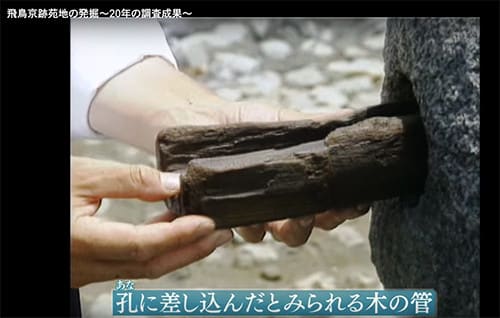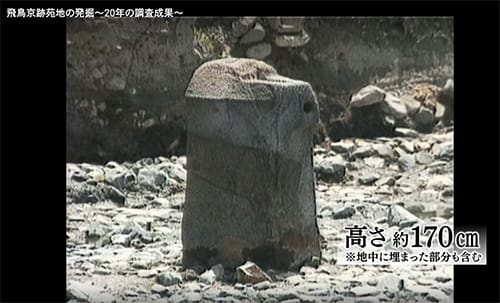



「噴水」という言葉の定義はわからない。この石器構造物のことを
「流水装置」というようにも言えるのかも知れない。
日本の「噴水」始原については金沢兼六園まで時代が下るという説もある。
しかし最近2019年段階で橿原考古研究所が結論づけた飛鳥京苑池での
写真の導水装置システムは日本の噴水事始めと言ってもいいのではないか。
橿原考古研究所(正式名は奈良県立橿原考古学研究所)の以下のような紹介が
この古代施設についての意義を語っていると思う。
〜飛鳥の宮殿に隣接する「苑池」は規模も大きく、びっしりと石が
敷き詰められていてその迫力に驚かされます。
中国や朝鮮半島にもまったく同じタイプの苑池は見つかっておらず、
飛鳥時代の日本のあり方を物語る「苑池」の全容を見ることができます。〜
逆に言うとなぜその後、日本国内でこうした苑池・噴水装置が
建築技術として旺盛にならなかったのか、それも要探究だと思われる。
現状ではきわめて特異な遺構として古代史上に出現したというところ。
この苑池の南側の池は水深は30cm程度ということで、
底面にはびっしりと石が敷き詰められてプール状外観を形成している。
そこにこのような導水装置があって、単純に涼を楽しむとしたのか、
わたしの推測のように「水を扱う」技術力を象徴的に見せたのか、
その目的について現状では証言・記録は存在しない。
国際関係に否応なく目覚めさせられた段階の日本国、
白村江敗戦以降の国際情勢下での「外交」の場面を考えれば
日本の技術国力を示すことは一種の「侵略抑止力」だったのだろう。
やはり中国・朝鮮に類例がないというのがミソではないかと。
かの国などからの外交使節が帰国後の本国での報告時に
「日本にはこういう技術がありましたが・・・」と伝わったことだろう。

石をさまざまに加工利用して水を自由自在に扱う建築土木技術に対して
それが全国で城塞建築に応用されると考えれば、
この国を大軍船団で攻略したとしても侵略の勝利を見通せなかっただろう。
やや無謀だったと思える百済救援のための白村江への出兵後の
安全保障戦略としてこの苑池は外交の「武器」になった可能性。
きのうは石材の切石加工技術を見たけれど、この苑池でも
北池底面には写真のように切石でより精緻な石材加工も施されている。
わたしとしては日本の平和共存外交戦略の一環だと強く思えるのです。
そしてそうした観点からすれば唐が日本侵略を諦め、友好関係に転じて
「日本国号・天皇号」を結果的に承認していった東アジア世界の情勢と
重ね合わせられるように思えるのです。
その平和努力が実を結んでその後、苑池造作技術は重要性が低下し、
戦国期以降の兼六園まで顧みられなかった歴史と符合する。
火山列島国土で水田耕作を基本にする国土条件では
必然的に狭い利用可能耕地面積を高める土木建築技術の発展が自明。
やはりこの苑池遺構からはこのような推論が導き出されると思う。
さて現代世界でプーチンのような狂乱独裁者に対してどう国防すべきか、
日本社会の「強さ」が試される事態が再来してもいるのでしょう。
English version⬇
The True Meaning of the Asukakyo "Fountain" Exploring Asuka, Nara - 9
The Asuka-kyo Palace was a place for the Japanese to show off their national defense capabilities by demonstrating to China and Korea that they possessed "dangerous civil engineering and architectural technology. Japanese power that can be converted to military force. The Japanese power that can be converted to military force.
I don't know the definition of the word "fountain." I am not sure if this stoneware structure can be called a "fountain.
The origin of fountains in Japan can be traced back to Kanazawa Kenrokuen Garden.
There is a theory that the origin of "fountains" in Japan dates back to the Kenrokuen Garden in Kanazawa.
However, as of 2019, the Archaeological Institute of Kashihara recently concluded that the Asuka Kyoen Pond
The water conducting system in the photo may be said to be the beginning of fountains in Japan.The following introduction by the Archaeological Institute of Kashihara, Nara Prefecture (formally known as the Archaeological Institute of Kashihara, Nara Prefecture)
I think it speaks volumes about the significance of this ancient facility.
〜The "Garden Pond" adjacent to the Asuka Palace is large in scale and is paved with stones.
The "Garden Pond" adjacent to the Asuka Palace is large in scale and filled with stones, and its power is astonishing.
No other garden ponds of exactly the same type have been found in China or the Korean peninsula.
The entirety of the garden pond, which tells the story of Japan in the Asuka period, can be seen here. ~.Conversely, why were garden ponds and fountains not actively used as a building technology in Japan after that?
It is also important to investigate why these garden ponds and fountains did not flourish as a building technology in Japan after that.
At present, they appear in ancient history as extremely unique remains.
The pond on the south side of this garden pond is about 30 cm deep.
The bottom of the pond is covered with stones to form a pool-like appearance.
Is it simply to enjoy the coolness of the water with a water conducting device like this?
Or, as I guessed, was it to symbolically show the technical skill of "handling water"?
There is currently no testimony or record of its purpose.Japan was at the stage where it was forced to wake up to international relations.
Considering the "diplomatic" scene under the international situation after the defeat at the Hakuchon River
Japan's demonstration of its technological national strength was probably a kind of "deterrent force against invasion.
The fact that there is no precedent in China or Korea is the key.
When diplomatic envoys from other countries reported back to their home countries after returning to Japan, they would say, "Japan had this kind of technology....
When diplomatic envoys from those countries reported back to their home countries, they would have been told that "Japan had this kind of technology.
For architectural and civil engineering techniques that process and utilize stone in a variety of ways and handle water at will.
If one thinks of it being applied to fortress construction throughout the country.
Even if they had invaded this country with a large fleet of warships, they would not have been able to foresee victory in the invasion.
After the somewhat reckless expedition to the Baekchon River to rescue Baekje
This Enchonji could have been a diplomatic "weapon" as a security strategy.
Yesterday, we saw the stone quarrying technique.
The bottom of the north pond is also made of hewn stone, as shown in the photo.
I strongly believe that this is part of Japan's diplomatic strategy of peaceful coexistence.And from such a point of view, it is very likely that the Tang Dynasty gave up its aggression against Japan and turned to friendly relations with Japan.
and the situation in East Asia, where the Tang Dynasty gave up invading Japan, turned to friendly relations, and eventually approved the "Japanese name and Emperor".
The Tang Dynasty gave up its aggression against Japan and turned to friendly relations with Japan, and eventually approved the "Japanese name" and "Emperor of Japan.
After the peace efforts bore fruit, the importance of the garden pond construction technique declined, and the garden was not restored until the Kenrokuen Garden after the Sengoku Period.
This is consistent with the history of Kenrokuen Garden, which was neglected from the Warring States period onward.
In a volcanic archipelago where rice paddy cultivation is the basic land condition
It is obvious that the development of civil engineering and architectural technology to increase the usable arable land area is inevitable.
I believe that this is the inference that can be drawn from the remains of the garden pond.
How should we defend ourselves against a mad dictator like Vladimir Putin in the modern world?
The "strength" of Japanese society may be put to the test once again.










